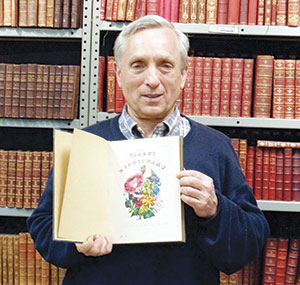
Hundreds of years of horticultural knowledge and lore are accessible through collecting books on gardening, according to Kenneth Gloss of the Brattle Book Shop.
By Kenneth Gloss
Pardon the pun, but gardening books are a perennial favorite with collectors. They have been around from the very first days of writing because they served as guides for the all-important agricultural tasks people had to do each day. The earliest versions of gardening books were nothing like what we think of today. They were advice books, filled with information on how to till the land, what seeds to select, when to harvest, etc. For a good example of a recreated 15th century gardening book, look for De Boke (The Garden Book) by Jenny Day Haynes, published in 1906. This book is a replica of what one might find 500 hundred years ago.
It wasn’t until the mid-1700s to the 1800s that gardening books offered more landscaping tips. Many of these books were large folio size with hand-colored drawings of plants and flowers, similar to the Audubon books that were printed then. These elaborate, beautiful books can run up to hundreds of thousands of dollars. Many print dealers will buy these books and take them apart, mounting the individual drawings to sell as prints.
By 1880, the world was still very much an agricultural society. Gardening for Profit by Peter Henderson, published in 1884, offered a complete do-it-yourself guide for gardening. However, these plots weren’t today’s typical 10-by-10 square feet with a few tomato plants and some cucumbers. Gardens in those days were a few acres in scope. Peterson’s book took the home gardener from beginning to end, explaining how to rotate crops for maximum soil usage, what plants worked well with others and other practical considerations.
Repton’s books in the 1800s were the first to offer detailed landscaping techniques and pictures. He had colored overlays in his book that helped people see what their landscaping would look like a few seasons down the road. Downing’s books, released around the same time, are one of the foremost American landscape architecture books. In cost, these can run from the hundreds to the low thousands, depending on condition and rarity. Repton’s books run a little higher, in the $2000 to $5000 range. Both authors helped cross that barrier between gardening as a necessity for life and gardening as a means of bringing beauty to one’s environment.
As society changed, so did the books on landscape and nature. Olmstead’s famous Emerald Necklace of parks throughout the Boston area spurred an interest in green spaces and beautifying civic areas. At the same time, a number of people were espousing the health benefits of open air, encouraging them to garden more often.
Seed catalogs are an excellent reflection of the times as well. In them, one can see what vegetables were popular, how flowers began to gain in demand and what tips the catalog manufacturers offered. Early seed catalogs were done with lithographic plates, making them worth hundreds and sometimes thousands of dollars. Later catalogs manufactured around the turn of the century, featured prints and photographs. These editions are also popular with print dealers.
Gardening shoots off into so many different areas that one can specialize in virtually any type of gardening. From rock gardens to water gardens, Japanese gardens to flower arranging, just about anything to do with flora and fauna takes root in gardening books. Many people like to specialize in one particular type of flower. Notes on Lilies, by Dr. Wallace, published in 1879, is an example of a book that delves deeply into the care and origin of different lily varieties. It details every step of tending to lilies, making it a comprehensive, targeted book for that one subject area. There are also books on indoor gardens, container gardens, even organic gardening. Rodale’s series on organic fertilizers and pest control is still popular today with people who want to return to more natural ways of raising plants.
Many of the pamphlets and smaller ephemera dealing with gardening are also interesting. Simple how-to brochures on repelling pests or how to construct an elaborate water garden have been produced for dozens of years. Some of these items, like the Farmer’s Almanac, are so plentiful that they aren’t worth much in terms of collecting. The Farmer’s Almanac was at its peak in popularity during the 1800s, resulting in a plethora of copies.
Anytime you say the word “gardening,” most people immediately picture vegetable gardens. For the book collector, however, amassing a collection in this area almost requires specialization because there are so many different categories and subcategories to choose from. For instance, one could narrow their collection to flowers, narrow further to roses, finally specializing in growing roses in Florida. Most people who choose this area for collecting love the outdoors and love the hands-on aspects of gardening as much as they do the books. Often, they belong to a horticultural society or other group that allows them to share their interest in plants. An interest in gardening books can serve many purposes: not only can interacting with other collectors provide social activity, but the process of getting outside and tilling the soil has great benefits for the mind and body.
Kenneth Gloss is the owner of the Brattle Book Shop in downtown Boston. It’s the oldest antiquarian bookstore in America. This is the 64th year of Gloss family ownership. He has been seen as a guest appraiser numerous times on PBS’Antiques Roadshow. Visit them at 9 West Street in downtown Boston and at their website: www.brattlebookshop.com for a list of his free and open talks or call 800-447-9595.















Reader Comments